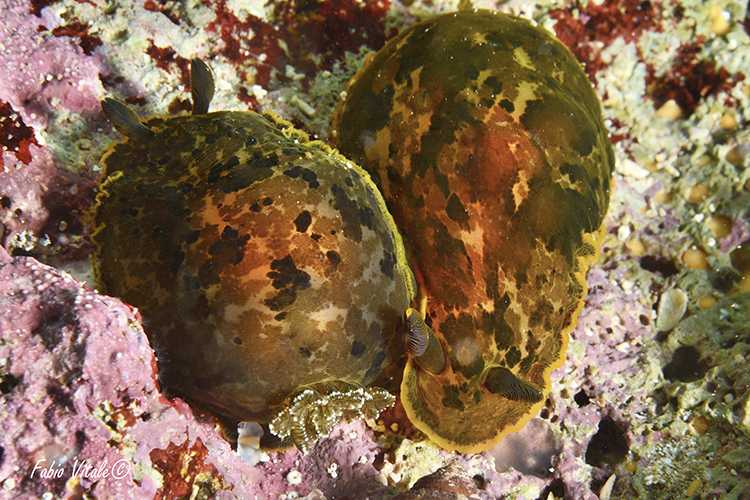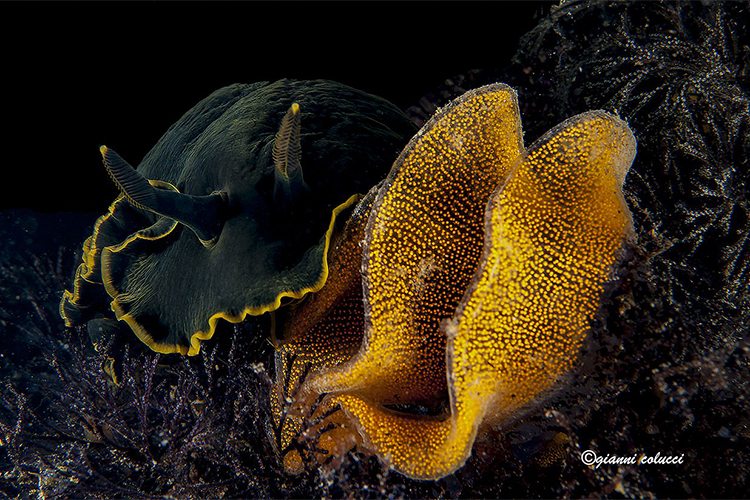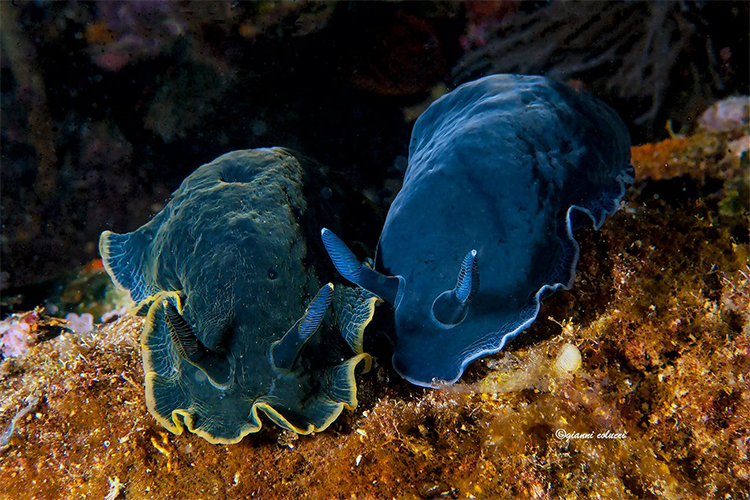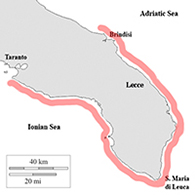Order: Nudibranchia Cuvier, 1817 - Suborder: Doridina
Family: Dendrodorididae O'Donoghue, 1924
Dendrodoris limbata (Cuvier, 1804)
|
 |
|
Specie piuttosto comune lungo il litorale salentino ionico, a bassa pronfondità e molto spesso sotto grosse pietre. E' dotata di una notevole variabilità cromatica, da esemplari gialli chiarissimi screziati di nero ad esemplari intermedi, maculati, con chiazze color marron e giallastro, con quelli più scuri, a tinta unita, in certi casi quasi neri, Sempre visibile l'orlo giallo che delimita la parte superiore del mantello. Rather common species along the Ionian Salento coast, with low depth and very often under large stones. It is endowed with a notable chromatic variability, from very light yellow specimens streaked with black to intermediate specimens, spotted, with brown and yellowish patches, with darker ones, solid color, in some cases almost black, The yellow edge is always visible which delimits the upper part of the cloak
|
 |
 |
 |
||
Esemplare fotografato in Mar Piccolo (Taranto) Specimens from Mar Piccolo (Taranto, Italy) |
 |
|
| Mar Piccolo (Taranto, Italy)
|
 |
|
Abbiamo messo queste due immagini volutamente in coda per evidenziare la particolarità di alcuni esemplari che possono essere osservati nel Mar Piccolo a Taranto, ci riferiamo all'esemplare alla destra della prima foto, quello con l'orlo del mantello color blù. We have deliberately placed these two images in queue to highlight the particularity of some specimens that can be observed in the Mar Piccolo in Taranto, we refer to the specimen on the right of the first photo, the one with the edge of the blue coat |
 |
|
L'esemplare poteva far pensare ad un'altra specie d'origine Indopacifica Dendrodoris fumata (Ruppell & Leuckart, 1831), conosciuto per il Mar Rosso e che quindi potenzialmente potrebbe essere entrato in Mediterraneo. Gli esemplari sono stati esaminati geneticamente e sono risultati appartenere entrambi alla specie mediterranea Bellissime le foto dell'amico Gianni Colucci (Mar Piccolo, 8m, 13° fondo roccioso misto) The specimen could suggest another species of Indo-Pacific origin Dendrodoris fumata (Ruppell & Leuckart, 1831), known for the Red Sea and therefore potentially could have entered the Mediterranean. The specimens were genetically tested and both were found to belong to the Mediterranean species. Beautiful photos of his friend Gianni Colucci (Mar Piccolo, 8m, 13 ° mixed rocky bottom |
 |
|
Bibliography Perrone A., 1983 Opistobranchi (Aplysiomorpha, Pleurobrancomorpha, Sacoglossa, Nudibranchia) del litorale salentino (Mar Jonio) (Elenco - contributo primo). Thalassia Salentina. 13 : 118 – 144 Perrone A.S., 1986 Opistobranchi (Aplysiomorpha, Pleurobrancomorpha, Sacoglossa, Nudibranchia) del litorale salentino (Mare Jonio) (Elenco - Contrib.secondo). Thalassia Salentina. 16 : 19 - 42. Furfaro G., Vitale F., Licchelli C. e Mariottini P. 2020 Two Seas for One Great Diversity: Checklist of the Marine Heterobranchia (Mollusca; Gastropoda) from the Salento Peninsula (South-East Italy) Diversity 2020, 12, 171; doi:10.3390/d12050171 GALIÀ-CAMPS C., CERVERA J. L., VALDÉS A. & BALLESTEROS M. 2022. Attack on crypsis: Molecular and morphological study of Dendrodoris Ehrenberg, 1831 (Mollusca: Gastropoda: Nudibranchia) from the Mediterranean Sea and Northern Atlantic Ocean reinstates Dendrodoris temarana Pruvot-Fol, 1953 https://doi.org/10.11646/zootaxa.5133.3.4 |
||

